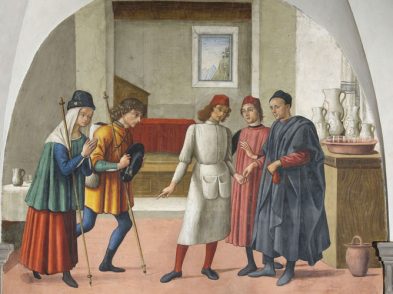A century ago, on October 19, 1909 Cesare Lombroso, physician,
psychiatrist and the founder of the Italian school of criminology or, as we
know it today, criminal anthropology, died at age 74 of angina pectoris at his
home in Turin.
In his trailblazing works,
especially the five editions of L’uomo delinquente (Criminal Man) first
published in 1876, Lombroso laid the foundations of this new science. He
classified criminals into two categories, each with an additional three
subcategories. The first category included three main types of criminals: born
criminals, insane criminals and epileptic criminals. His second category,
instead, was divided into occasional, criminoloid, and habitual criminals, all
of whom differed from the first category because they were not, in the
Lombroso’s view, ‘anthropologically’ criminal.
Lombroso believed that although
the typical behaviour of criminals in his first category was, to a small
extent, conditioned by their socio-economic environment, it was mainly shaped
by factors beyond their control. Effectively, he maintained, their
physiological and physiognomical nature was influenced by hereditary factors or
mental disorders that diminished their responsibility. These lineaments,
Lombroso posited, were most frequently demonstrated by the shape of a
criminal’s skull and other parts of the body, like a club-shaped nose, the
proximity of the eyes, jutting ears, limited facial hair, prominent canine
teeth, sloping shoulders, long arms and pointy fingers. How the criminal
expressed himself through letters, graffiti, drawings and tattoos was also
important. By measuring and drawing these pronounced anatomical, physiognomic
and physiological traits of the ‘born criminal’ in particular, Lombroso
concluded that they were similar to those of primitive or atavic man.
Therefore, the ‘born criminal’ had no choice but to commit crimes. This,
naturally, guided Lombroso’s perspective on punishment. Far ahead of his era,
he believed in prevention and rehabilitation rather than deterrence because, in
his view, punishment should protect society rather than exact retribution from
the criminal who could not help himself.
Born Ezechia Marco Lombroso into
a wealthy Jewish family in Verona on November 6, 1835, Lombroso studied at the universites of Pavia, Padua and Vienna. As
a young doctor, he dedicated time and money in trying to help the poor, the
marginalized and the insane, especially by treating peasant farmers in Lombardy, who suffered from cretinism and pellagra.
After Italy’s unification, he joined the military medical corps
and was sent to Calabria. It was not, however, until 1864 that he became
interested in crime when he began studing the often obscene tattoos that, he
believed, distinguished ‘the dishonest from the honest soldier’.
From this, he moved on to what became
his life’s work, the application of experimental scientific methods for
exploring the criminal mind. In 1866, he became a visiting professor at the University
of Pavia
and, in 1871, the director of the Pesaro
asylum, where he developed the idea of asylums for the criminally insane. He
returned to the University
of Pavia
in 1872 and began in ernest his studies that lead to his theory of the criminal
man. At the Unversity of Turin, in 1878, he was appointed professor of forensic
medicine; in 1896, professor of psychiatry and, in 1905, professor in criminal anthropology.
Starting from his time in the army, Lombroso collected
skulls, skeletons, brains and other objects related to his studies which formed
the basis of his private collection. Once a professor of forensic medicine, he
moved the collection from his home to the university and set up what would
later become one of Italy’s
most macabre museum. He added craniums from distant places and, later, those of
criminals, prostitutes and madmen. Next he added murder weapons, photographs,
drawings, charts and instruments for taking scientific measurements, followed.
As Lombroso’s fame grew, other scholars sent intersting pieces to embelish the
collection of which he himself would eventually become a part. Fulfilling his
final wishes when he died, his family gave parts of his body to the museum.
Today, on the basis of new empirical evidence, many of
Lombroso’s theories have been debunked as being, at best, bizarre or, at worst,
dangerous because they could, out of the context of the times in which he
lived, be interpretated as racist, sexist and discriminatory. Reinforcing the
social hierarchy of his day, many of his studies tended to ‘demonstrate’ the
inferiority of criminals to honest people, of women to men, and of blacks to
whites.
However, his work was still very significant and
should not be diminished or underrated. Influenced by the contemporary interpretation
of Darwin’s
social theories, Lombroso was unquestionably a positivist product of his day.
He was the first scholar to pay attention to the criminal as a person and on
the causes of criminal behaviour. Focusing on scientific analysis, he accumulated
a wealth of case studies. He examined the cadavers of executed criminals and
recorded the stories of criminals like the notorious outlaw Giuseppe Musolino.
Above all, he meticulously categorised his subjects with the exacting eye of
criminology’s first psychological profiler.
Thanks to the fact that his
books were translated and published around the world, Lombroso became a celebrity.
His theory on the atavistic or born criminal dominated European and American
thinking during the late nineteenth and early twentieth centuries and, although
the ‘scientific’ methods he employed are considered flawed according to modern
standars, criminal anthropology still plays a role in the study of social and
forensic psychology.
Museo di Antropologia criminale ‘Cesare Lombroso’ dell’Universita
di Torino
(www.museounito.it/lombroso) has been restored and will re-open in November 2009 in
celebration of Lombroso’s centenary.








